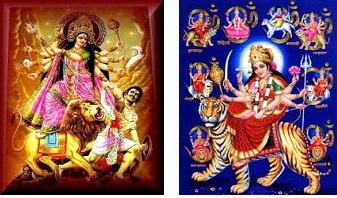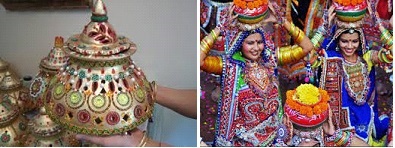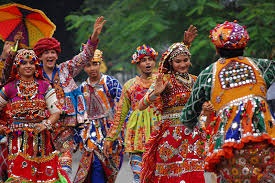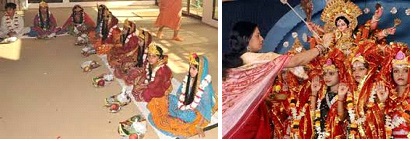
The Raas Garba or Garba, an ancient folk dance from the state of Gujarat in Western India is a very popular dance form. Garba is performed during the nine–day Navratri festival in the Hindu month of Ashwin, which usually falls between September to October. Women dance by forming a circle around an earthen pot called ‘Garba’, which is lit from the inside and is called as the Garbhdeep. A type of circular and spiritual dance, the Garba symbolises divine interpretation that the lamp with the light inside has divinity. It is also seen as a sign of respect to the Mother Goddesses and a celebration of womanhood. The call of ‘Ae Hallo’, vibrant music, colourful costumes, sparkling jewellery and an unmatched devotion mark the season of Garba. Let us learn about this dance in detail.
According to a few mythological legends, the demon Mahisasura was killing and harassing innocent people. To stop him from doing so, the trio of Lord Shiva, Vishnu and Brahma united and created Goddess Durga or Maa Durga. Durga fought with the Mahisasura for nine days and finally killed him on the tenth day. To commemorate this win over evil, the nine day Navratri festival is celebrated especially by women by playing Garba. It is a mark of respect for Maa (Mother) Durga and her various avatars such as Maa Jagdambe, Maa Saraswati and Maa Laxmi. Another legend says that Lord Rama worshipped Maa Durga in nine forms, for nine days to gather power and strength to kill the Ravana, the demon king who had abducted Sita. According to one more legend, Usha, the granddaughter –in–law of Lord Krishna popularized Lasya Nritya, which is also known as the modern–day Garba.

Garba is usually performed by women for nine consecutive days. Commencing in the night, it starts with the worship of nine Goddesses, one on each day. A perforated earthen pot with a lamp inside is placed outside the house. After the rituals, the women who are dressed in finery, form a circle around the pot, claps their hands in a rhythmic motion and move around the circle with forward and backward movements of the hands and the legs. In their traditional style, women place the decorated pots on their head and move in a circular motion. Also sometimes, an image of the Goddess is placed at the centre and women dance around it. Singing of songs, clapping of hands and synchronized movements mark this dance. Each state of India celebrates Garba in a unique way. Sometimes men join in and nowadays, professional troupes perform Garba to the beats of the orchestral music.

In its traditional style, the Garba is performed to the sound of the flute, folk instruments such as the drum, harmonium and taal along with the clapping of hands. The very popular Sanehdo compositions are played along with a musical instrument called Daklu. Daklu resembles a drum and sets the tempo. However, nowadays, synthesizers and orchestral music are more associated with the Garba performance.
Navratri Garba is known for its colourful vibrant form. Women wear colourful attires and adorn themselves with heavy, oxidized jewellery. The traditional dress is a sari worn in a Gujarati style. The chaniya choli, which consists of a colourful embroidered skirt, blouse and an odhani that covers the head, is the most preferred dress for women. Men also wear a colourful embroidered top, a turban and a colourful dhoti.

Garba is chiefly associated with the celebration of womanhood and its strength. The nine forms of Maa Durga who are worshipped for nine days are the symbols of femininity, strength and power. Though the fasting and rituals are followed by men also, it is the women who perform the main tasks of devotion. On the eighth day (Ashtami) of Navratri, nine young girls are worshipped, offerings are made and blessings are sought. This ritual is called Kanchika Puja. Women play a major role and are ably supported by men folk.



